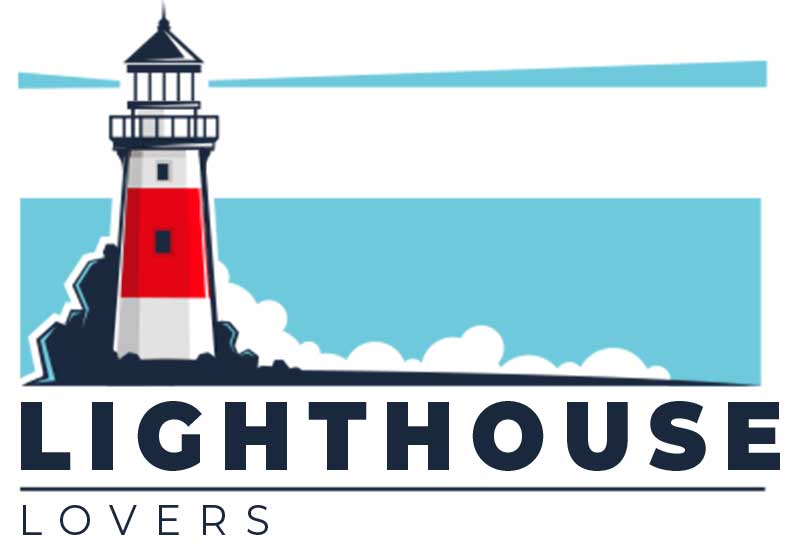Godrevy Lighthouse
Virginia Woolf's Lighthouse
Virginia Woolf based her famous novel „To the Lighthouse“ on Godrevy Lighthouse at the entrance to St. Ives Bay. My experience of visiting the lighthouse was exactly the same as James Ramsay’s in the book: the boat trip to the island did not materialise. Instead, I had a closer encounter with Virginia Woolf on a bench in Richmond-upon-Thames, London, and she even posed for a selfie with me!
Godrevy Lighthouse
Godrevy Island, Cornwall, United Kingdom
St Ives Bay, Celtic Sea
Not yet visited. I went to see the Virginia Woolf statue in London in June 2024 instead.
Facts & figures
Godrevy Lighthouse is located on the island of the same name, 3.5 miles across St. Ives Bay. This reef, known as The Stones, is a dangerously treacherous. It has been a hazard to shipping and a hotspot for wreckers plundering for centuries. After the loss of the iron screw steamer Nile and all its passengers and crew on 30 November 1854, it was decided to build a lighthouse. It went into use in 1859. The name Godrevy is Cornish and means ‘little huts, little homesteads’.
Right next to the tower were the keepers’ cottages. There were to be two keepers on duty at all times. Their shifts were to be two months on and one month off. This was not always the case, as can be seen from the example of Assistant Keeper W. J. Lewis. He was left stranded on the island between Christmas and New Year after his colleague was brought ashore with pneumonia on 25 December 1925. Due to the poor weather conditions, relief didn’t arrive until 2 January. He had to keep the light and the foghorn running all the time, so he wouldn’t have had much sleep. Here you can read his full story: A lighthouse keeper’s recollections of being stuck alone in 1925.
The lighthouse was finally made automatic in 1934, which was no doubt a great relief to everyone. Nowadays, the island’s only inhabitants are seabirds.
Godrevy Lighthouse has been solar-powered since 1995. In 2012, the light was moved from the lighthouse tower to a new steel framework on the adjacent rock. The Grade II listed tower is now serving as a daymark.
The model for Virginia Woolf's famous novel „To the Lighthouse“
Virginia Woolf’s renowned novel “To the Lighthouse” is set on the Isle of Skye in the Hebrides, but the lighthouse is based on Godrevy. Virginia Woolf spent many of her childhood summers at Talland House in the Cornish town of St. Ives. Her parents, Julia and Leslie Stephen, purchased the magnificent Edwardian villa overlooking St. Ives Bay and Godrevy Lighthouse in 1882, the year Virginia was born.
Talland House sits above Porthminster Beach, and Virginia had a clear view of Godrevy Lighthouse across the bay. It was there that she spent all her summer holidays until her mother’s death in 1894.
Virginia Woolf went to see the lighthouse. Her visit on 12 September 1892 is confirmed by the guest book, which she signed. Godrevy Lighthouse still had keepers at that time.
Talland House was converted into flats in the 1950s and isn’t open to the public. If you want to get a feel for the house, you can take in the garden, the house and the view to the iconic Godrevy Lighthouse from Talland Road above. The gardens have recently been brought back to their former glory by heritage horticulturist Polly Carter to exactly how they would have looked during Virginia Woolf’s time.
In September 2022, a commemorative plaque was installed on the house.
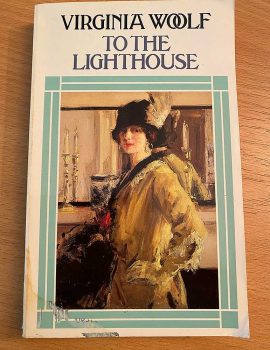
By Virginia Woolf
1926, London
1927, Hogarth Press, London
The Omnipresent Promise Of A Lighthouse Visit
The modernist novel “To The Lighthouse” is set on the Isle of Skye in Scotland, which takes place in the years leading up to and following World War I.
It revolves around the Ramsay family’s summer holiday. The story may lack a plot, but it is unquestionably acclaimed by critics for its innovative narrative techniques and exploration of the complexities of the human experience.
The story begins with James, aged six, longing to embark on a journey to the lighthouse. However, the promise of a visit is always put on hold because Mr Ramsay, James’s father, always finds a reason why the trip can’t be made. Mrs Ramsay, the mother, feels sorry for her son.
James finally makes the trip a decade later. His mother has died in the meantime, and his father takes the sixteen-year-old and his sister there at last.
You can read the full text, get a summary, and find a study guide on sparknotes.com.

Lighthouse Quotes From The Book
I just have to share with you the most memorable lighthouse quotes from the book for me!
“Yes, of course, if it’s fine tomorrow,” said Mrs. Ramsay. “But you’ll have to be up with the lark,” she added. To her son these words conveyed an extraordinary joy, as if it were settled, the expedition were bound to take place, and the wonder to which he had looked forward, for years and years it seemed, was, after a night’s darkness and a day’s sail, within touch.
„The Window“, chapter 1
James Ramsay (6), looking forward for the journey to the lighthouse
“But,” said his father, stopping in front of the drawing-room window, “it won’t be fine.” Had there been an axe handy, a poker, or any weapon that would have gashed a hole in his father’s breast and killed him, there and then, James would have seized it.
„The Window“, chapter 1
James' disappointment and anger at his father
(…) Mrs. Ramsay could not help exclaiming, “Oh, how beautiful!” For the great plateful of blue water was before her; the hoary lighthouse, distant, austere, in the midst; and on the right, as far as the eye could see, fading and falling, in soft low pleats, the green sand dunes with the wild flowing grasses on them, which always seemed to be running away into some moon country, uninhabited of men.
„The Window“, chapter 1
Mrs. Ramsay looking out over St. Ives Bay and admiring the lighthouse in the distance
But he wanted to ask her something more. Would they go to the Lighthouse tomorrow? No, not tomorrow, she said, but soon, she promised him; the next fine day. He was very good. He lay down. She covered him up. But he would never forget, she knew, and she felt angry with Charles Tansley, with her husband, and with herself, for she had raised his hopes.
„The Window“, chapter 18
Mrs Ramsay feels guilty once again for failing to keep her promise to her son
Indeed they were very close to the lighthouse now. There it loomed up, stark and straight, glaring white and black, and one could see the waves breaking in white splinters like smashed glass upon the rocks. One could see lines and creases in the rocks. One could see the windows clearly; a dab of white on one of them, and a little tuft of green on the rock. A man had come out and looked at them through a glass and gone in again. So it was like that, James thought, the lighthouse one had seen across the bay all these years; it was a stark tower on a bare rock.
„The Lighthouse“, chapter 13
Mrs. Ramsay looking out over St. Ives Bay and admiring the lighthouse in the distance
Sitting on a Bench with Virginia Woolf
Enjoying my breakfast on the banks of the Thames in Richmond, London, I noticed a statue of a woman sitting on a bench in a nearby park. Her clothes were a little out of date, but she blended in perfectly with the scenery. And there she was: It was none other than the famous writer Virginia Woolf (1882–1941) herself, looking out over the Thames with a book in her hand! I asked her if I could sit with her and if she would pose for a selfie with me, as she didn’t seem to be reading at the moment and was smiling at me in a friendly manner. “I’d love to,” she said. “I’d even like people to stop for a selfie on my bench!”
Meeting Virginia completed a circle for me. My journey began in Cornwall, home of the very lighthouse she used as a model for her bestseller, “To The Lighthouse”. It ended in London, where I sat on a bench with the literary icon.
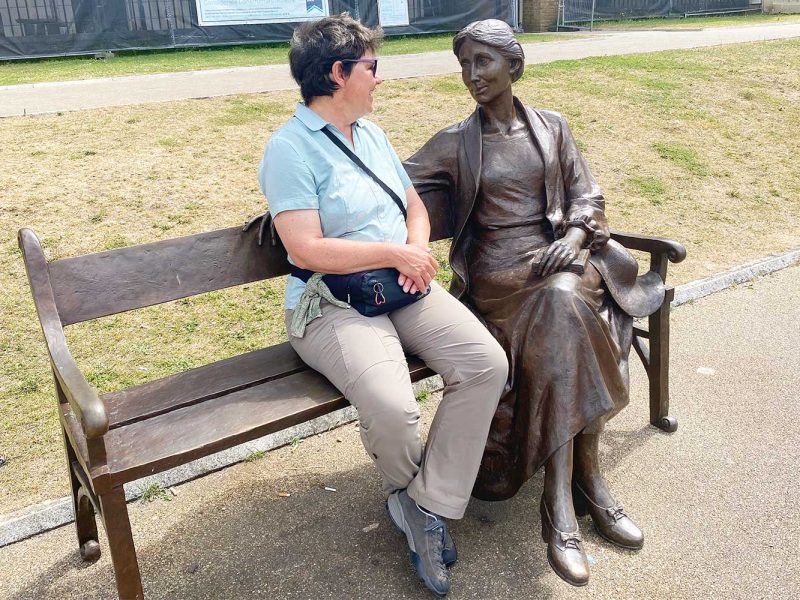
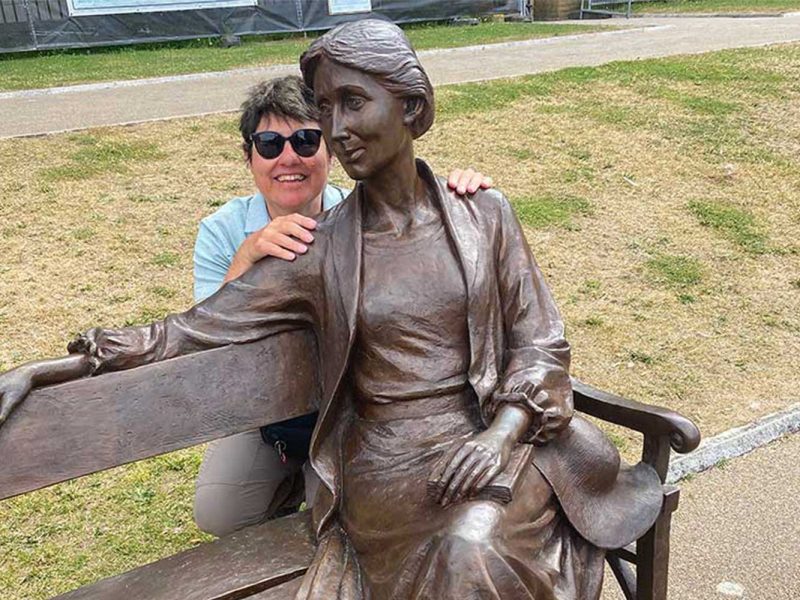
Selfie with Virginia Woolf: The famous writer didn't mind posing with me!
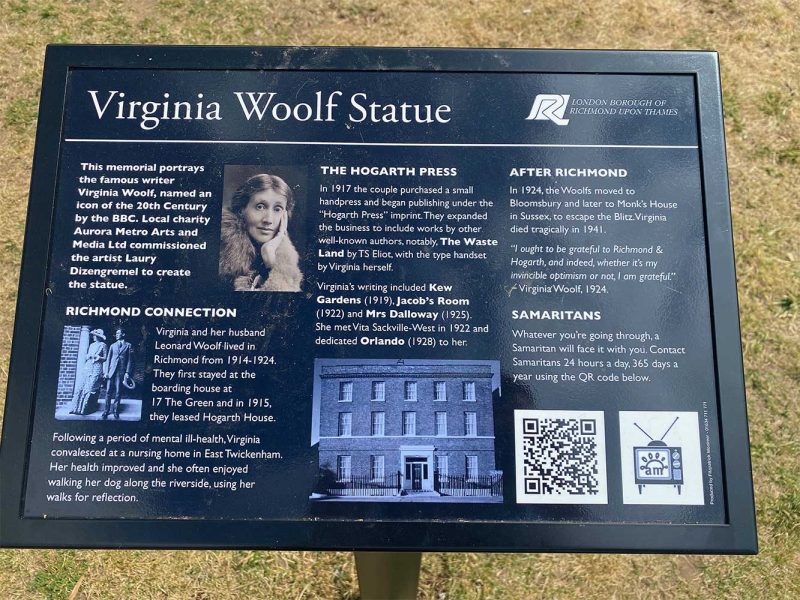
Offer of help from the Samaritans on the explanatory plaque.
The bronze statue, created by artist Laury Dizengremel, was unveiled in November 2022. The initial resistance to the choice of location on the waterfront was proven to be unfounded. As Virginia Woolf drowned in the River Ouse in East Sussex in 1941, it was feared that the proposed site could distress mentally unstable people. The London Borough of Richmond upon Thames has included an offer of help from the Samaritans on the explanatory plaque accompanying the statue. It reads: “Whatever you’re going through, a Samaritan will face it with you. Contact Samaritans 24 hours a day, 365 days a year using the QR code below.”
You Can't Get enough?
Here you can find some of the other lighthouses that I have visited.
